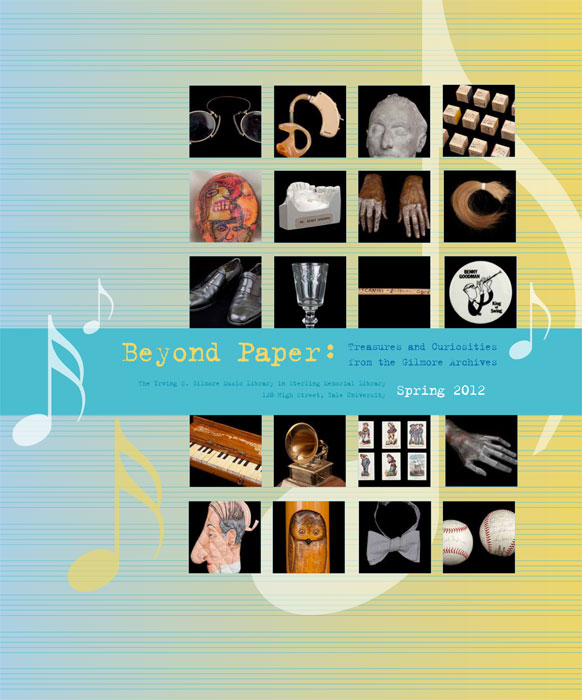Beyond Paper: Treasures and Curiosities from the Gilmore Archives

The Gilmore Music Library is home to numerous important archival collections, including the papers of Charles Ives, Vladimir Horowitz, Benny Goodman, Kurt Weill, Virgil Thomson, and Robert Shaw. We also hold individual musical manuscripts in the hands of J.S. Bach, Mozart, Beethoven, Brahms, and many other notable musicians. Most of our exhibits—such as the recent ones honoring the 200th birthdays of Mendelssohn, Chopin, Schumann, and Liszt—are designed to showcase manuscripts, letters, books, scores, engravings, and photographs that are important for scholarly research. But our collections are not limited to words, musical notes, and visual images written or printed on paper.
In Beyond Paper: Treasures and Curiosities from the Gilmore Archives, we have chosen instead to display a diverse assortment of other objects. Some of them document important moments in music history; you will see the baton from Arturo Toscanini's last concert before the outbreak of World War II, as well as the Grammy Award that Vladimir Horowitz won for his famous 1965 Carnegie Hall recital, his first public performance after a twelve-year retirement. Others are more surprising, such as an Easter egg decorated by Paul Hindemith, or baseballs autographed for Horowitz by members of the New York Mets and St. Louis Cardinals in 1969. Several objects remind us that the great musicians had physical bodies: Henry Gilbert's baby hair, Robert Shaw's dental X-rays, and casts of the hands of Horowitz and Chopin, of Benny Goodman's teeth, and of Gilbert's face. Their bodies sometimes needed a little help: we have Thomas de Hartmann's glasses, Virgil Thomson's hearing aid, and J. Rosamond Johnson's cane. Madeleine Forte's practice keyboard was designed to strengthen the fingers of the young pianist. But our musicians also had a sense of fun; the exhibit includes a musical game devised by Gilbert, as well as two decks of playing cards—one designed by Arnold Schoenberg, and the other featuring characters from the H.M.S. Pinafore.
The Gilmore Library's collections include hundreds of items of this kind, so our exhibit has to omit many worthy possibilities. A rose kissed by Liszt was included in our recent Liszt exhibit, and the board that John Kirkpatrick used for playing tone clusters in the Concord Sonata of Charles Ives is currently on loan to Carnegie Hall. The papers of Horowitz, Shaw, and Goodman each include numerous Grammys, along with a multitude of honorary degrees and other awards—more than enough for an exhibit in their own right. —Richard Boursy, Archivist
